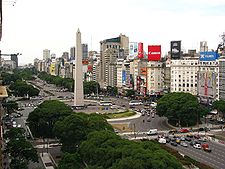
Plaza de la República (Buenos Aires)
Encyclopedia


Buenos Aires
Buenos Aires is the capital and largest city of Argentina, and the second-largest metropolitan area in South America, after São Paulo. It is located on the western shore of the estuary of the Río de la Plata, on the southeastern coast of the South American continent...
, capital of Argentina
Argentina
Argentina , officially the Argentine Republic , is the second largest country in South America by land area, after Brazil. It is constituted as a federation of 23 provinces and an autonomous city, Buenos Aires...
. It is located in the San Nicolás
San Nicolás, Buenos Aires
San Nicolás is one of the neighbourhoods of the city of Buenos Aires, Argentina, sharing most of the city and national government structure with neighboring Montserrat and home to much of Buenos Aires' financial sector...
quarter, at the intersection of the city's three main arteries : Ninth of July Avenue
9 de Julio Avenue
Avenida 9 de Julio is a wide avenue in the city of Buenos Aires, Argentina. Its name honors Argentina's Independence Day, July 9, 1816.The avenue runs roughly one kilometer to the west of the Río de la Plata waterfront, from the Retiro district in the north to Constitución station in the south...
, Corrientes Avenue
Corrientes Avenue
Avenida Corrientes is one of the principal thoroughfares of the Argentine capital of Buenos Aires. The street is intimately tied to the tango and the porteño sense of identity...
, and Diagonal Norte. It derives its name and associations from a church once sited on the square, San Nicolás de Bari (demolished in the 1930s for the creation of 9th of July Avenue), where the country's national flag was hoisted for the first time.
The plaza is the site of the Obelisk of Buenos Aires
Obelisk of Buenos Aires
The Obelisk of Buenos Aires is a national historic monument and icon of Buenos Aires. Located in the Plaza de la República, in the intersection of avenues Corrientes and 9 de Julio, it was built to commemorate the fourth centenary of the first foundation of the city.In order to enrich the...
, both designed by Alberto Prebisch
Alberto Prebisch
Alberto Prebisch was a distinguished Argentine architect whose numerous works included private houses, apartment and office blocks, cinemas, shops and banks...
and inaugurated in 1937. The plaza, originally a circular esplanade paved in stone, was enlarged to its current dimensions in 1962. Its present layout was established in 1971, when Corrientes Avenue was rerouted through the plaza and around the obelisk to ease car traffic into the city's financial district.
Metro
Three lines of the Buenos Aires MetroBuenos Aires Metro
The Buenos Aires Metro , locally known as Subte is a mass-transit system that serves the city of Buenos Aires, Argentina. The first station of this network opened in 1913, the first of its kind in South America, the Southern Hemisphere and the entire Spanish-speaking world...
have connecting stations underneath the plaza, and are accessible from either side of the Ninth of July Avenue. These are:
- "Carlos Pellegrini" station on the LineLine B (Buenos Aires)Line B of the Buenos Aires Metro runs from Leandro N. Alem to Los Incas/Parque Chas . Line B opened to the public on 17 October 1930....

- "9 de Julio" station on the LineLine D (Buenos Aires)Line D of the Buenos Aires Metro runs from Catedral to Congreso de Tucumán. The D Line opened on 3 June 1937 and has been expanded to the north several times. The line is currently 10.41 km long and runs approximately parallel to the city's coastline....

- "Diagonal Norte" station on the LineLine C (Buenos Aires)Line C of the Buenos Aires Metro that runs from Retiro to Constitución terminus, opened on 9 November 1934, and it has a length of 4.3 km.-Stations and connections:-Murals:...

Together they offer an easy route around most of the important places in the capital.

